Spotlight on Old Hazelton
June 2, 2020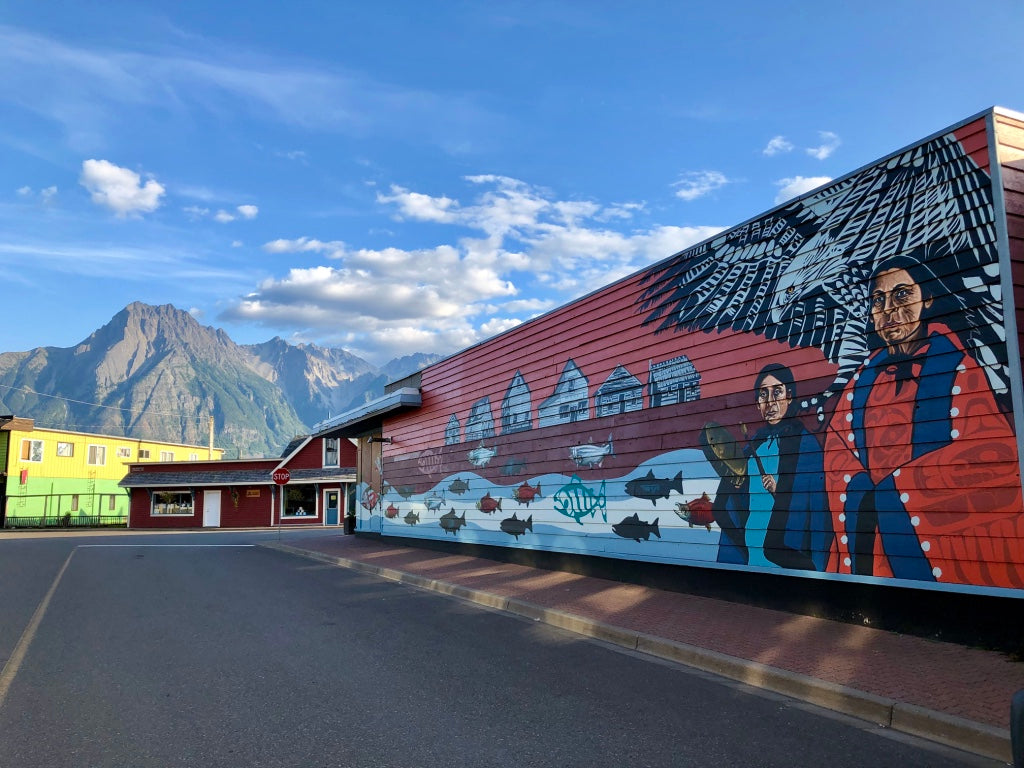
Sometimes the smallest places have
the biggest stories to tell.
 We begin our Canadian Summer Arts Tour in Northwestern B.C. under the towering gaze of the Rocher Deboule Mountain range. This is the heart of Gitxsan territory. Today just over 300 inhabitants remain nestled between the Skeena and Bulkley rivers, in the little town of Old Hazelton. It might seem like a tiny speck on the map but this place was once a thriving cultural epicentre. While visitors can still wander through the totems and explore a few longhouses in the ‘Ksan Historic Village, Gitanmaax School, the first academic institution to offer formal instruction on Northwest Coast art, has long closed its doors. Government cuts and industrial outsourcing have all contributed to the town’s economic decline. It’s a familiar tale, but by no means one destined to a tragic ending.
We begin our Canadian Summer Arts Tour in Northwestern B.C. under the towering gaze of the Rocher Deboule Mountain range. This is the heart of Gitxsan territory. Today just over 300 inhabitants remain nestled between the Skeena and Bulkley rivers, in the little town of Old Hazelton. It might seem like a tiny speck on the map but this place was once a thriving cultural epicentre. While visitors can still wander through the totems and explore a few longhouses in the ‘Ksan Historic Village, Gitanmaax School, the first academic institution to offer formal instruction on Northwest Coast art, has long closed its doors. Government cuts and industrial outsourcing have all contributed to the town’s economic decline. It’s a familiar tale, but by no means one destined to a tragic ending.
In August 2019 the first licks of paint were made to the wooden side of Inlander Grocery. Over the next month a mural began to take shape. Aptly named ‘The Return’, a collaboration of four local artists did much more than add colour to the side of a wall, it brought together their bruised community.
This isn’t just a story about Old Hazelton, it’s a story about Canada – how the power of unifying creatively to instil beauty, pride and a sense of civic hope, should resonate with our national identity. It is told by three of the contributors.
Professional painter and designer Leah Pipe, arrived in Old Hazelton twenty years ago, the fourth generation of Pipes to do so.
Roy Henry Vickers, CM OBC, world-renowned First Nations artist and Gitanmaax alumnus, spent his childhood in the area and returned with his family in 2004.
Michelle Stoney is a Gitsxan/Cree, Northwest Coast contemporary artist. She grew up in Gitanmaax, is an Emily Carr graduate and recipient of the prestigious Fulmer Award.
LEAH PIPE

The Dream – 48×72″

Raven Girl – 30×36”
It’s always been a dream of mine to incorporate murals into our community. Not only do these paintings unify us, boosting morale and pride but they implant a sense of history and culture, showing visitors who the residents are and how they live. When Old Hazelton started to empty and become a ghost town, I found it even more pressing to incorporate public art. I could see it was more important than ever to do something that was proactive, artistic and creative.
A couple of years ago, I finally had some success moving the project forward. Some community members joined in to help me push for it and the brakes came off.

I Will Bring You Home – 16×20”
I got a small crew of local artists together to help out and in short, realised that transforming this large, old wall with weathered siding on an old building in Old Hazelton, was going to be a daunting task. Privately recognising that I bit off more than I could chew, I started putting in calls – I really needed people to come out in droves to help!
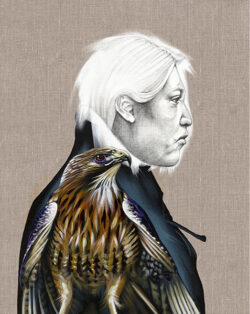
We Are The Unfinished Ones – 16×20”
I purposely designed the mural with areas that people could paint, even if they’d never picked up a brush. Then there were more complex parts, so more skilled individuals could join in. It was really, really incredible because the community did come out in droves – children and elders and all sorts showed up to lend a hand. This did pose an interesting challenge in terms of being a project manager.
I had 30 to 50 people over the course of a month, teaching them how to paint on one hand while guiding the process on the other. Plus I had to reserve time for the parts that I needed to do. But as the lead artist, the act of working together was fascinating. We had intense weather and technical challenges, but it really bonded the community. That intersection where the mural is on the building has never been so busy. There were bottleneck traffic jams because people would stop in the street and get out and talk. It was incredible. A buzz and hub for a month. And it did exactly what I had hoped – it brought us all together, creating these amazing discussions about the future of the town and its cultural prospects.It’s something we haven’t had in 20 years.
ROY HENRY VICKERS

The Homecoming
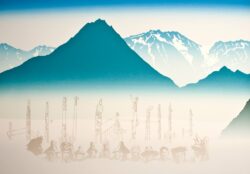
A Meeting of Chiefs
Leah approached me and asked if I could step in and help put some of my art onto the mural. When she described the piece as a return of the salmon, it was natural for me. I’m part of the Salmon People, the village Gitanmaax is part of the Salmon People and the salmon have always been the staple of the people. Today, like everything else, overfishing has brought a huge decline in the return of salmon from the coast. Few care about wild salmon anymore. Our struggle is to bring back a love of these wild fish and the pristine, wild river that rages right past my front door.
As we started to work, you could see and feel a small revival beginning. It wasn’t just the mural, the mural was one small part of it. It looks big because it’s on the side of a building, but it’s really an example of what art and artists can do in a community. Artists have always been the voice of where we should go, or what’s inspiring. To me that mural is an example of the strength of the art that exists in Hazelton, and yet, we get taken for granted because we’ve always been here. The mural excited people and brought them to a realisation that, ‘hey, wait a minute, we have some incredible artists in this community, and we should be celebrating them.’
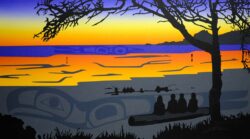
Sandcastles
Now our creation stands but everything’s quiet again. It’s like we need a spark. We need a place that will bring artists together constantly, not just once a year in celebration of a finished mural and then everybody leaves.

Westcoast Sunset
I was one of the first students who came through the Gitanmaax School back in the early 70s. At that time, the traditional style village of ‘Ksan was really the loudest voice for the arts and culture of the Pacific Northwest. I’m filled with memories and nostalgia of when the town was thriving and alive. Hazelton mostly depended on the logging industry which died when the government decided that all our trees were going to be shipped overseas to be turned into lumber before getting sent back. With that, the income for the town disappeared. And yet the beauty is still here. I imagine this quiet little place being revived by people like myself, Leah Pipe, and Michelle Stoney. Who knows how many others could rise to the occasion, but we need an occasion. There are artists in the community but there isn’t a community of artists. I would love to see a new art’s centre. There’s actually a building right in the middle of the town, next to where I used to live. It’s empty and for sale. I envision it being bought by the Misty Rivers Arts Council or a group of patrons, to be developed into a place where artists like myself could go and teach or work for a day or two and just be there for the public to meet. We need to create a space like ‘Ksan, to bring the art culture alive again in Hazleton. When a fire is ignited the people will stay to feed the flames and keep them burning.
MICHELLE STONEY
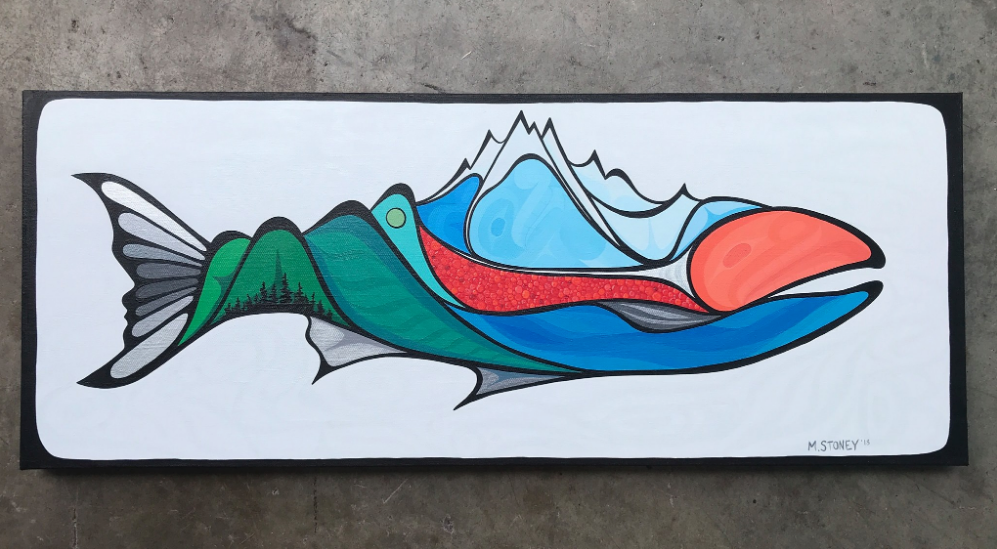
I grew up in Gitanmaax / Old Hazelton. Right now I am living right down by ‘Ksan campground and that’s where my studio is located. My grandfather (ye’e) was the father figure in my life. He was one of the people who went to the Gitanmaax School and he also taught Gitxsan art in the local secondary. Growing up I used to love watching him create. I never thought I would be an artist, but when I told my ye’e my plans he said he always knew I’d follow in his footsteps.
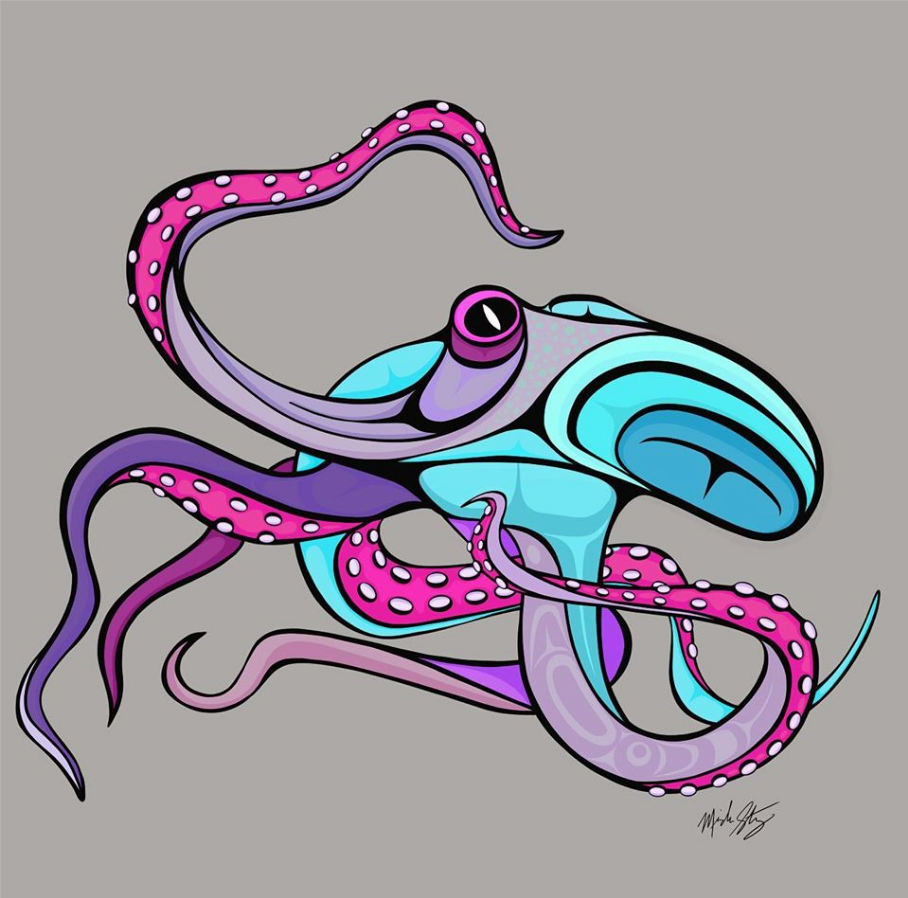 My art is definitely influenced by my surroundings. When I came home from university (I graduated from Emily Carr in 2012) I didn’t think I would stay in Hazelton long, so I set out to paint what was around me before I left. When I was growing up I kind of took for granted where I lived. I always loved our local mountain but it wasn’t until I moved away and came back that I really started to realise how amazing this place is. I especially took notice of Stekyooden (Rocher Deboule). I loved how it changed every season, transformed during the day, and how you could see it from almost every Gitxsan village. So I decided to do a series on it. I used the paintings of that series in my first show and it was a hit. I don’t think I’ll ever stop painting Stekyooden. Nature is a huge part of me and I think that’s why I try to add it to my art.
My art is definitely influenced by my surroundings. When I came home from university (I graduated from Emily Carr in 2012) I didn’t think I would stay in Hazelton long, so I set out to paint what was around me before I left. When I was growing up I kind of took for granted where I lived. I always loved our local mountain but it wasn’t until I moved away and came back that I really started to realise how amazing this place is. I especially took notice of Stekyooden (Rocher Deboule). I loved how it changed every season, transformed during the day, and how you could see it from almost every Gitxsan village. So I decided to do a series on it. I used the paintings of that series in my first show and it was a hit. I don’t think I’ll ever stop painting Stekyooden. Nature is a huge part of me and I think that’s why I try to add it to my art.
I didn’t hear about ‘The Return’ until Leah asked me to collaborate with her in the summer of 2019. She wanted me to fill in one of the robes she had in the design. By the time I joined the mural a lot of work had already been done. Leah had me paint the red bottom blanket. At the time it was surrounded by an eagle she had painted. I just reinterpreted what she’d done in formline. I didn’t wade in with a plan, Leah just let me do what I wanted and when I showed her my idea she loved it.
I always say I represent my community when I do my art. I wouldn’t be able to do what I do without their amazing support. We have so many great artists in my community who I look up to and who give me guidance and encouragement.

Being Canadian and First Nations is a touchy subject nowadays. Growing up, I used to be very proud of being Canadian. For the Olympics I redid the Canadian flag with formline. I used that as a self portrait in one of my classes while I was at university, implying that I am a First Nations in Canada. I love where I come from and I love the land. I’ve been to each province and have friends all over the country. I wouldn’t want to be anywhere else. The best thing about Canada is that it is multicultural. I do like how people are starting to recognize the different indigenous cultures, especially in British Columbia. I think when people think about Northwest Coast formline they think of B.C. – they think of the art and they think of the people. In that respect, what defines Canada to me is that everyone has the liberty to share their culture freely.
Our Canadian Summer Arts Tour will continue throughout the months of June and July. Join in and submit your art and ideas around weekly themes. Together let’s explore and capture the spirit of our unique home.
See more of these featured artists’ work on their websites!
Leah Pipe: leahpipeartist.com
Roy Henry Vickers: royhenryvickers.com
Michelle Stoney: michellestoney.com
